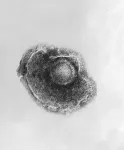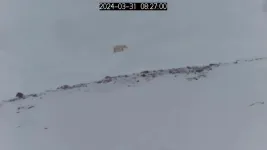(Press-News.org) Biomass burning—whether from wildfires, wood stoves or agricultural fires—sends massive amounts of tiny particles and chemicals into the air. These emissions are not just an environmental issue; they pose serious health risks, especially for our lungs. An Environmental Pollution study, co-authored by Dr. Jason Surratt, a professor in the Department of Chemistry at UNC-Chapel Hill, reveals how two key components of biomass smoke—levoglucosan and 4-nitrocatechol—affect human lung cells. Their findings suggest that aged smoke, which has undergone chemical changes in the atmosphere, could be even more dangerous than fresh smoke.
Biomass burning refers to the combustion of organic materials like wood, leaves and crop residues. This process releases large amounts of carbon-based aerosols, which contribute to air pollution. Among the many chemicals produced in the smoke, levoglucosan and 4-nitrocatechol serve as important markers. Levoglucosan is a sugar-like compound released when wood burns, while 4-nitrocatechol forms when smoke interacts with nitrogen oxides in the atmosphere, a process known as chemical aging. While scientists have long studied the environmental effects of biomass burning, less is known about how these compounds directly impact human health.
In the study, “Evidence for Cytotoxicity and Mitochondrial Dysfunction in Human Lung Cells Exposed to Biomass Burning Aerosol Constituents: Levoglucosan and 4-nitrocatechol,” Dr. Surratt and colleagues at the UNC Gillings School of Global Public Health, Polish Academy of Sciences and Príncipe Felipe Research Center Foundation (CIPF) conducted laboratory experiments to compare how levoglucosan and 4-nitrocatechol affect human lung cells.
They used two different types of lung cells: BEAS-2B cells, which represent normal lung-lining cells, and A549 cells, which come from lung cancer tissue and are commonly used in respiratory studies. The researchers exposed these cells to different concentrations of levoglucosan and 4-nitrocatechol over 24 and 48 hours. They then measured cell survival, stress levels and signs of damage to the cells’ mitochondria—the “power plants” of cells that generate energy.
Their key findings were that aged smoke is more toxic:
The study found that 4-nitrocatechol was significantly more toxic to lung cells than levoglucosan. At relatively low doses, 4-nitrocatechol reduced cell survival and caused oxidative stress—an imbalance that damages cells and can lead to lung diseases.
Exposure to 4-nitrocatechol disrupted the function of mitochondria in lung cells, leading to a process called apoptosis, or programmed cell death. This damage could contribute to long-term lung problems.
While levoglucosan exposure also led to cellular stress, its effects were much less severe compared to 4-nitrocatechol. Cells exposed to levoglucosan showed signs of mitochondrial stress, but they were able to recover over time.
Since 4-nitrocatechol forms when biomass smoke reacts with urban air pollutants like nitrogen oxides, areas affected by both wildfires and traffic pollution may be particularly at risk.
While wearing an N95 or P100 mask can help filter out fine particles, it may not fully protect against toxic gases and chemicals present in aged smoke. Here are some steps individuals can take: Use HEPA air purifiers to remove fine particles from indoor air and keeping windows and doors closed can help minimize smoke infiltration; ensure that homes are properly sealed to prevent smoke from entering through cracks, vents or poorly fitted windows and doors; avoid using candles, gas stoves or burning wood indoors, as these can add to indoor air pollution; in extreme conditions, individuals with respiratory issues or prolonged exposure may consider investing in gas masks with activated carbon filters, which can help remove both particles and harmful gases; and if air quality levels are hazardous and exposure is prolonged, relocating to an area with cleaner air—either indoors with filtered ventilation or to a different location—might be the safest option.
“Our study reinforces concerns that exposure to biomass smoke—especially aged smoke containing 4-nitrocatechol—can have serious health consequences,” said Dr. Surratt. “Long-term exposure to these pollutants has been linked to respiratory diseases such as asthma, chronic obstructive pulmonary disease and lung cancer. People who live in wildfire-prone areas or who frequently burn wood for heating should take extra precautions.”
END
Study finds aged biomass emissions could pose greater risk to lungs than fresh wildfire smoke
2025-02-27
ELSE PRESS RELEASES FROM THIS DATE:
Four research teams rethink particleboard construction and reuse
2025-02-27
For a few hundred dollars, a bedroom can be refreshed with the latest flat-pack offerings. Wood particleboard furniture is affordable and generally easy to assemble, but particleboard is often held together with formaldehyde-based resins that make it hard or impossible to recycle. Now, with the help of science, old pressed-wood furnishings could be repurposed, and new modular decor could incorporate more environmentally friendly materials. Four articles published in ACS journals reveal how. Reporters can request free access to these papers ...
Deep-learning framework advances tissue analysis in spatial transcriptomics
2025-02-27
Biological tissues are made up of different cell types arranged in specific patterns, which are essential to their proper functioning. Understanding these spatial arrangements is important when studying how cells interact and respond to changes in their environment, as well as the intricacies of pathologies like cancer. Spatial transcriptomics (ST) techniques, which have been rapidly evolving over the past decade, allow scientists to map gene activity within tissues while keeping their structure intact, ...
From dormant to danger: How VZV reactivation is driving CNS infections
2025-02-27
The varicella zoster virus (VZV), an infectious virus from the herpes virus family, is primarily known to cause varicella in children and shingles in adults. But lately, this virus has also been reported to trigger severe complications like central nervous system (CNS) infections. Researchers from Fujita Health University, Japan, conducted a comprehensive study spanning 10 years (2013–2022), to identify the VZV-related infections affecting the CNS. Their study reveals a marked increase in adult VZV-related CNS infections, ...
DNA barcodes narrow down possible sources of introductions of an invasive banana skipper butterfly pest
2025-02-27
CABI has led a team of scientists who have used DNA barcodes to narrow down the possible sources of introductions of an invasive banana skipper butterfly, with implications as to the threat of it spreading to Africa and tropical America.
The banana skipper, Erionota torus Evans (Lepidoptera, Hesperiidae, Hesperiinae, Erionotini) is a South-east Asian pest of banana that, in the last 60 years, has spread to the southern Philippines, Taiwan, Japan, India, Sri Lanka, Mauritius and La Réunion.
The new research, published in the journal CABI Agriculture and Bioscience, analysed a partial library of DNA barcodes from the indigenous and introduced ranges and suggests that aircraft are likely ...
Transforming clinical care for children with rare genetic diseases
2025-02-27
Global partnerships that embed scientific research into clinical care are revolutionising the diagnosis and treatments for children with rare genetic diseases, according to a new report.
The white paper found despite advances in genomic technologies, which can detect rare genetic diseases within days, there remained significant challenges to ensuring this leads to improved child health outcomes. But global collaborations, such as the International Precision Child Health Partnership (IPCHiP), using evidence-based approaches to inform decisions in real-time, are overhauling patient care.
The paper was led by Murdoch Children’s Research Institute (MCRI), The Hospital for Sick ...
Polar bear cubs emerging from their dens for the first time: New study captures rare footage
2025-02-27
Svalbard, Norway – February 27, 2025 – Researchers from Polar Bears International, San Diego Zoo Wildlife Alliance, the Norwegian Polar Institute, and the University of Toronto Scarborough reveal the first detailed look at polar bear cubs emerging from their dens, captured through nearly a decade of remote camera footage in Svalbard, Norway. This research, published today on International Polar Bear Day in the Journal of Wildlife Management, marks the first combination of satellite tracking collars with remote camera traps to answer ...
Turning waste organic compound into useful pharmaceuticals and energy using a technique inspired by photosynthesis
2025-02-27
A research team led by Assistant Professor Shogo Mori and Professor Susumu Saito at Nagoya University has developed a groundbreaking method of artificial photosynthesis that uses sunlight and water to produce energy and valuable organic compounds, including pharmaceutical materials, from waste organic compounds. This achievement represents a significant step toward sustainable energy and chemical production. The findings were published in Nature Communications.
“Artificial photosynthesis involves chemical reactions ...
Violence alters human genes for generations, researchers discover
2025-02-27
In 1982, the Syrian government besieged the city of Hama, killing tens of thousands of its own citizens in sectarian violence. Four decades later, rebels used the memory of the massacre to help inspire the toppling of the Assad family that had overseen the operation.
But there is another lasting effect of the attack, hidden deep in the genes of Syrian families. The grandchildren of women who were pregnant during the siege — grandchildren who never experienced such violence themselves — nonetheless bear marks of it in their genomes. ...
Scientists discover key protein in resilience to stress
2025-02-27
When faced with chronic stress, why do some people develop anxiety and depressive symptoms while others show resilience? A protein that acts as a cannabinoid receptor and is present in the structure controlling exchanges between the bloodstream and the brain could be part of the answer, according to a study published today in Nature Neuroscience.
“The protein, called cannabinoid receptor type 1 (CB1), is part of the blood-brain barrier, the dynamic structure that protects the brain by regulating the passage of molecules between the bloodstream and ...
Nasal spray shows preclinical promise for treating traumatic brain injury
2025-02-27
A new study led by researchers at Mass General Brigham suggests a nasal spray developed to target neuroinflammation could one day be an effective treatment for traumatic brain injury (TBI). By studying the effects of the nasal anti-CD3 in a mouse model of TBI, researchers found the spray could reduce damage to the central nervous system and behavioral deficits, suggesting a potential therapeutic approach for TBI and other acute forms of brain injury. The results are published in Nature Neuroscience.
“Traumatic brain injury is a leading cause of death and disability — including cognitive decline ...





